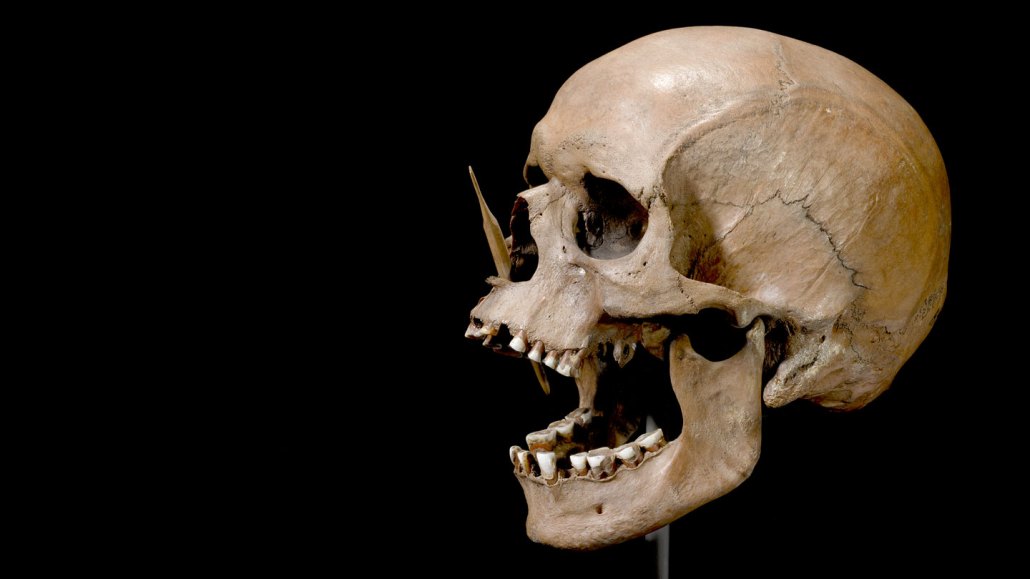
A Danish bog skull known as Porsmose Man, found with an arrow that had been shot through his nose, dates to around 4,600 years ago. Ancient DNA analyses now indicate that incoming herding groups transformed the genetic profiles of people, including the Danes, throughout northern Europe at that time.
The Danish National Museum
Ancient herders, who rode horses and drove ox-drawn carts west out of their grassy homelands in southwest Asia, erased a DNA divide between far-flung farmers and hunter-gatherers-fishers around 5,000 years ago.
The molecular legacy of these ancient herders, known as the Yamnaya people, reshaped Eurasians’ genetic profile, impacting everything from their descendants’ height to their susceptibility to some diseases (SN: 3/3/23). For instance, it left people today with predominantly northern European ancestry especially prone to developing multiple sclerosis. An international team of researchers describes these results, based on analyses of DNA from more than 1,600 ancient individuals, as well as new hints about the origins of the Yamnaya in four papers published January 10 in Nature.
The new DNA evidence fleshes out what’s known about the extent of Yamnaya people’s genetic reach. It reveals that the Yamnaya mated with members of a distinctive eastern European culture — named the Globular Amphora Culture for its large, globe-shaped vessels — before expanding into northern Europe, say evolutionary biologist Morten Allentoft, of Curtin University in Perth, Australia, and colleagues. That hybrid population adapted rapidly to its new surroundings and formed a dominant culture that archaeologists call the Corded Ware Culture, Allentoft’s group hypothesizes (SN: 11/15/17).
These genetic discoveries align with previous archaeological evidence, says archaeologist Volker Heyd of the University of Helsinki, who did not participate in the new research. Corded Ware Culture artifacts also display stylistic contributions from non-Yamnaya people who came from northern, forested parts of western Asia, Heyd notes.
To conduct their analysis, Allentoft and colleagues combined newly extracted DNA from the bones and teeth of 317 Europeans and western Asians with previous genetic data from more than 1,300 ancient Europeans. Most sampled individuals lived between 11,000 and 3,000 years ago.
Although much remains unknown about Yamnaya ancestry, the new DNA evidence traces a large portion of these herders’ genetic origins to hunter-gatherers who lived near what’s now western Russia’s Don River. Remains of those hunter-gatherers excavated at an ancient graveyard in Russia called Golubaya Krinitsa date to around 7,300 years ago, the researchers say.
Archaeological finds place the origin of Yamnaya culture at around 5,400 to 5,300 years ago, so evidence of their genetic ancestry emerging two millennia earlier “is quite a surprise,” Heyd says. He suspects that hunter-gatherers whose more than 7,000-year-old remains and artifacts have been found across a big chunk of southwestern Asia, not just at the Russian graveyard, contributed to Yamnaya genetic origins.
The ancient advance of herders into Europe produced a serious genetic downside. Yamnaya people endowed northern Europeans today with a heightened genetic risk for multiple sclerosis, or MS, a disease in which the body’s immune cells attack the brain and spinal cord, say University of Cambridge computational biologist William Barrie and colleagues.
MS affects more than 2.5 million people worldwide. Precisely how genes, environmental factors and viruses produce MS is unknown (SN: 8/11/22). MS rates reach as high as 303 per 100,000 individuals among northwestern Europeans, including Scandinavians, about twice the rates documented for most southern Europeans.
Barrie’s group compared ancient Eurasians’ DNA to modern DNA already collected from around 410,000 white British individuals. The researchers calculated that specific gene changes previously linked to a risk for developing MS emerged around 5,000 years ago among Yamnaya herders. Yamnaya migrations brought those gene variants to northern Europe where they continue to cluster at a high rate.
“Our analyses indicate that MS gene variants helped people survive in the past,” Barrie said at an online news conference held by the researchers in Copenhagen on January 9. Gene changes linked to MS boosted Yamnaya herders’ immune defenses against diseases transmitted from their horses, cattle, sheep and goats, the researchers suspect.
Modern, sanitized environments have altered immune systems in ways that have increased MS risks for those who inherit these once advantageous genes for herders, they speculate. “This is the first evidence of this [evolutionary process] in an autoimmune disorder,” Barrie said.
Other inherited disease risks also emerged from the new analyses of ancient DNA. For instance, present-day eastern Europeans — who display considerable ancestry from ancient hunter-gatherers in that region — inherited elevated levels of a risk gene for Alzheimer’s disease, APOE4, from those groups, Barrie’s team finds (SN: 9/22/17). Past benefits of this gene variant are unclear.
In a separate analysis, University of Copenhagen geneticist Evan Irving-Pease and colleagues uncovered an association between Yamnaya ancestry and taller adult heights and lighter skin tones in ancient and modern northern Europeans relative to their southern counterparts.
In another surprise, tall, light-skinned Yamnaya people or their direct descendants served as the ancestors of modern Danes after reaching what’s now Denmark around 4,850 years ago, Allentoft and colleagues report in a separate paper. Yamnaya descendants replaced farmers who had settled in the region after displacing native hunter-gatherer groups about 1,000 years earlier, the researchers say.
Danish archaeologists often assume that present-day Danes have descended from hunter-gatherers who occupied what’s now Denmark 14,000 to 15,000 years ago as the last Ice Age waned, Allentoft’s group says.






